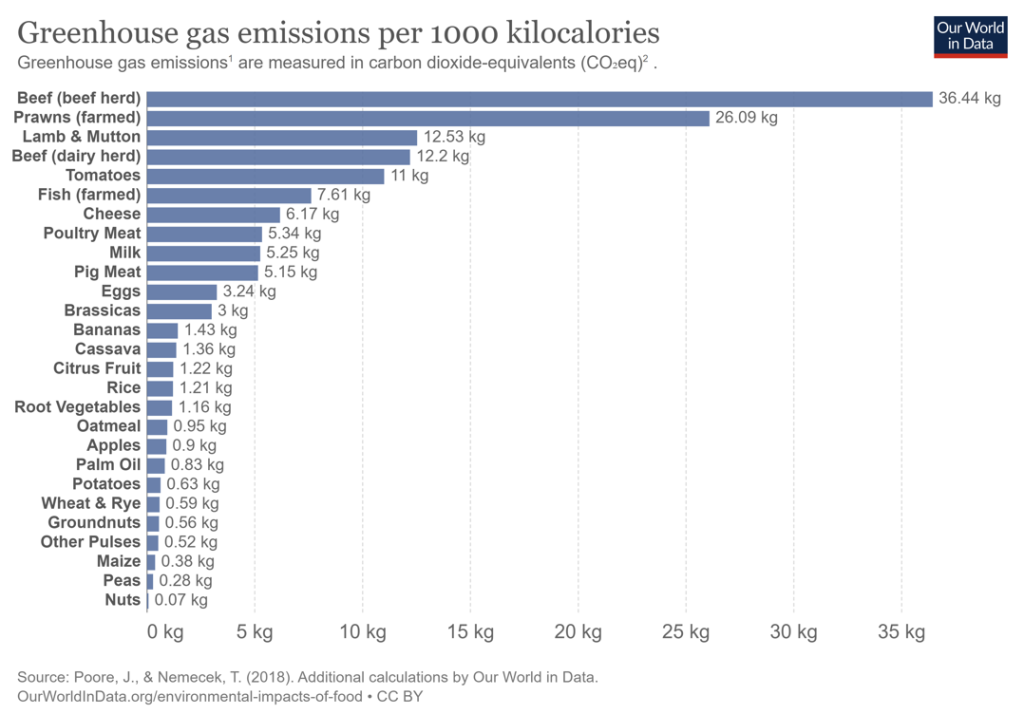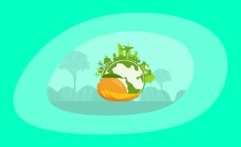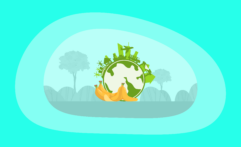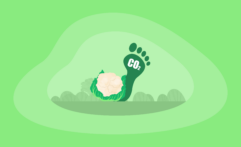What Is the Carbon Footprint of Bananas? A Life-Cycle Analysis
Impactful Ninja is reader-supported. When you buy through links on our site, we may earn an affiliate commission.
Learn more
Learn more
.
Hey fellow impactful ninja ? You may have noticed that Impactful Ninja is all about providing helpful information to make a positive impact on the world and society. And that we love to link back to where we found all the information for each of our posts. Most of these links are informational-based for you to check out their primary sources with one click. But some of these links are so-called "affiliate links" to products that we recommend. First and foremost, because we believe that they add value to you. For example, when we wrote a post about the environmental impact of long showers, we came across an EPA recommendation to use WaterSense showerheads. So we linked to where you can find them. Or, for many of our posts, we also link to our favorite books on that topic so that you can get a much more holistic overview than one single blog post could provide. And when there is an affiliate program for these products, we sign up for it. For example, as Amazon Associates, we earn from qualifying purchases. First, and most importantly, we still only recommend products that we believe add value for you. When you buy something through one of our affiliate links, we may earn a small commission - but at no additional costs to you. And when you buy something through a link that is not an affiliate link, we won’t receive any commission but we’ll still be happy to have helped you. When we find products that we believe add value to you and the seller has an affiliate program, we sign up for it. When you buy something through one of our affiliate links, we may earn a small commission (at no extra costs to you). And at this point in time, all money is reinvested in sharing the most helpful content with you. This includes all operating costs for running this site and the content creation itself. You may have noticed by the way Impactful Ninja is operated that money is not the driving factor behind it. It is a passion project of mine and I love to share helpful information with you to make a positive impact on the world and society. However, it's a project in that I invest a lot of time and also quite some money. Eventually, my dream is to one day turn this passion project into my full-time job and provide even more helpful information. But that's still a long time to go. Stay impactful,Affiliate Disclosure
Why do we add these product links?
What do these affiliate links mean for you?
What do these affiliate links mean for us?
What does this mean for me personally?
![]()
Bananas are the most-consumed fruit in the US. Furthermore, over 100 billion bananas are consumed every year globally. They are popular because of their nutritional value, versatility in baking, and relatively low prices. But, bananas take a considerable amount of resources to produce which can increase their carbon emissions. So, we had to ask: What is the carbon footprint of bananas?
Bananas have a moderate carbon footprint of 0.21 kg (0.48 lb) of CO2e per pound of banana. The main factors that contribute to these emissions are transportation fuel, pesticides, and plastic waste. They have a relatively high carbon footprint compared to many other fruits.
In this article, we will look at the full life-cycle of bananas, investigating how each stage contributes to their carbon footprint. We will go through all of the main stages of the bananas’ production – starting with growth and then going through harvesting, processing, transportation, and ending at waste disposal – and will evaluate how that stage contributes to the bananas’ carbon footprint. So, let’s get into the carbon footprint of bananas!
Here’s How We Assessed the Carbon Footprint of Bananas
The carbon footprint is one of the ways we measure the effects of our human-induced global climate change. It primarily focuses on the greenhouse gas (GHG) emissions associated with consumption, but also includes other emissions such as methane (CH4), nitrous oxide, and chlorofluorocarbons, and is generally expressed in carbon dioxide equivalents (CO2e).
“Carbon footprint: the amount of greenhouse gasses and specifically carbon dioxide emitted by something (such as a person’s activities or a product’s manufacture and transport) during a given period”
Merriam Webster
Basically, it is the amount of carbon emitted by you as an individual or an organization providing you with goods and services – including bananas:
- This includes GHG emissions from producing the products that we use and foods that we eat (e.g., power plants, factories or farms, and landfills)
- GHG emissions from fuel that we burn directly or indirectly (e.g., logistics and transportation, cooling or heating facilities),
- as well as the GHG emissions attributed to how we consume these products and foods.
To understand the carbon footprint of bananas, we must assess their life-cycle and each stage’s sustainability. This life-cycle assessment (LCA) is a method to evaluate the environmental impacts of products and materials.
Here’s the Overall Carbon Footprint of Bananas
The overall carbon footprint of bananas is 0.21 kg (0.48 lb) of CO2e per pound of banana. This is mainly due to their significant transportation distances as well as the use of pesticides, plastic packaging.
In comparison to other fruits, the carbon footprint of bananas is moderately high. However, there are a few factors that impact this, including the distance and method of transportation as well as the type of pesticide used.
| The carbon footprint of bananas | 0.21 kg (0.48 lb) of CO2e per pound of banana |
So, let’s have a look at each stage of the LCA of bananas!
| The life-cycle stages of bananas | Each stage’s carbon footprint |
| Growing of bananas | The growth stage of bananas has a small carbon footprint. The main contributors to this are the high pesticide use and some farms planting at low density. |
| Harvesting, processing, and packaging of bananas | The harvesting, processing, and packaging stage of bananas has a moderate carbon footprint. The main factors contributing to this are their excessive packaging and the energy used in the processing stage. However, bananas are harvested manually, which keeps their overall carbon footprint on the lower side. |
| Transporting of bananas | The transportation carbon footprint of bananas is moderate. They have less distance to travel than some other fruits, but they are still shipped internationally, and in refrigerated containers. This drives up their carbon footprint considerably. |
| End-of-life of bananas | The carbon footprint of banana waste is significant. This is mainly due to the low composting rates of food waste and the low recycling rates of plastic. |
As we can see from the table, transportation and waste are the two biggest contributors to the banana’s carbon footprint, with the growth stage and the processing stage having minor impacts. These are the bigger summaries of each stage of the banana’s impact, illustrating for you how they contribute to the carbon footprint. But each of those categories has a more complex story to tell. In the ensuing sections, we will dive deeper into each aspect of the banana’s production process.
What Is the Carbon Footprint of Growing Bananas
The growth stage of the banana has a small carbon footprint. The main contributors to this are the high pesticide use and some farms planting at low density.
The process of growing fruit can have a relatively high carbon footprint, depending on the methods used. Factors like the amount of irrigation, deforestation, and pesticide use can all contribute to the overall impact of the growth stage.
Which factors impact the carbon footprint of growing bananas?
- How do bananas grow: Contrary to popular belief, bananas do not grow on trees, but on tall bushes. The good news is that banana bushes can still sequester carbon very effectively. So, this stage of the growth process has a very low carbon footprint.
- What is the growth duration of bananas: Banana bushes take about 9 months to reach maturity. The individual plant takes about 3–4 months to transition from fruit to flower. This is a relatively short growth time compared to most other fruits. The longer a fruit takes to grow, the more resources it will need. So, this stage doesn’t contribute too significantly to the banana’s overall carbon footprint.
- What is the land usage of bananas: Bananas have a very wide-ranging density, holding anywhere from 1,600—10,000 bushes per hectare. Lower density means more land and resources are required. So, the more plants that can fit per hectare, the lower the carbon footprint. For this reason, the carbon footprint of this stage very much depends on the practice of the individual banana farm.
- What is the water usage of bananas: Bananas need about 1–1.5 inches of water per week. Most American-consumed bananas are grown in Guatemala, which gets about 50 inches of rain per year. This perfectly matches the banana’s needs, so they need very little irrigation. Therefore, this part of the growth process has a very low carbon footprint.
- What is the pesticide and fertilizer usage of bananas: Unfortunately, bananas use an above average amount of pesticides within fruit production. Pesticides emit a lot of carbon, so this stage of the growth process does contribute significantly to the overall carbon footprint of bananas.
Banana plants have carbon-sequestering properties, relatively short growth times, and minimal irrigation, meaning that they don’t require too many resources, and therefore carbon, to produce. The only downsides are the variability in their land use and their high pesticide use. But overall, they have a relatively low growth carbon footprint.
In short, despite the high pesticide usage and variable agricultural density, bananas have a low carbon footprint during the growth stage. This is because they grow quickly, require very little irrigation, and sequester carbon.
What Is the Carbon Footprint of Harvesting, Processing, and Packaging Bananas
The harvesting, processing, and packaging stage of bananas has a moderate carbon footprint. The main factors contributing to this are their excessive packaging and the energy used in the processing stage. However, bananas are harvested manually so this lowers their potential overall carbon footprint.
The next major stage in the life-cycle of bananas’ carbon emissions is harvesting, processing, and packaging, which involves picking the fruit, checking it for damage, sorting it, and getting it ready for distribution. And this stage can contribute greatly to the carbon footprint of the fruit.
Which factors impact the carbon footprint of harvesting, processing, and packaging bananas?
- How are bananas harvested: Bananas are primarily harvested by hand. This is very good news for their carbon footprint because no emissions are created during the harvesting process. Therefore, harvesting does not contribute significantly to this stage of the banana’s overall carbon footprint.
- How are bananas processed: Bananas have to be immediately chilled and sterilized following harvesting. This requires energy for refrigeration, and so it contributes moderately to the banana’s carbon footprint.
- How are bananas packaged: Bananas are packaged using a combination of cardboard and polythene. Both of these materials cause emissions and so contribute significantly to the banana’s overall carbon footprint.
Taking into account factors like their extensive packaging and the energy required to process them, but also their low carbon harvesting practices, this stage of the banana growing process has a moderate carbon footprint.
In short, harvesting, processing, and packaging is a moderate contributor to the banana’s overall carbon footprint. Manual processing keeps the carbon footprint relatively low, while the energy-consuming processing and the excessive packaging used are main contributors at this stage.
What Is the Carbon Footprint of Transporting of Bananas
The transportation carbon footprint of bananas is moderate. They have less distance to travel than some other fruits, but they are still shipped internationally, and in refrigerated containers. This drives up their carbon footprint considerably.
A banana’s journey has just started when it is packaged. They then have to travel the distance between the farm and the grocery store. The distance, as well as the method through which they have to travel, are the two most important factors in determining the carbon footprint of their transportation.
Which factors impact the carbon footprint of transporting bananas?
- Where are bananas grown: Bananas are primarily grown in Guatemala. This means that the majority of bananas that people consume in the US are imported, which greatly raises their carbon footprint. Though Guatemala is outside of the US, it is not as far as other fruit-growing regions like Asia or Oceania, which puts it on the moderate end of fruit imports in terms of carbon footprint.
- How are bananas transported: Bananas are transported to the US in refrigerated cargo containers on ships. Refrigerated cargo containers create far more emissions than non-refrigerated cargo ships, meaning that this stage does contribute significantly to the banana’s overall carbon footprint.
With the moderate distance bananas have to travel (especially compared to fruits that come from other continents) and the refrigeration required in their transport, bananas have a moderate transportation carbon footprint.
In short, transporting bananas does accrue a moderate carbon footprint. This is mainly due to the distance they have to travel and higher emissions from refrigeration.
What Is the Carbon Footprint of the End-of-Life of Bananas
The carbon footprint of banana waste is significant. This is mainly due to the low composting rates of food waste and the low recycling rates of plastic.
The banana’s ability to accrue a carbon footprint isn’t over after you consume them. In fact, one of the most important factors that will determine the overall carbon footprint of the banana is how its waste is disposed of.
Which factors impact the carbon footprint of the end-of-life of bananas?
- How are bananas disposed of: Bananas have a peel that is not edible, but it is completely compostable. However, due to the incredibly low composting statistics (at around 4%), it is highly likely that your banana peel will end up in landfill instead. Furthermore, throwing food waste in landfills generates methane, which is a very harmful greenhouse gas. Therefore, this stage is a significant contributor to your carbon footprint.
- How is the packaging of bananas disposed of: There are two main components to the banana’s packaging, both of which are before the consumer stage: cardboard and plastic. Cardboard actually has a remarkable recycling rate at 89%, whereas plastic has a low recycling rate, at around 9%. Because plastic is recycled so rarely, this stage also contributes significantly to the banana’s carbon footprint, despite the high recycling rates of cardboard.
Of the three components to banana waste—peels, cardboard, and plastic—only the cardboard is unlikely to end up in landfills. The other two will most likely end up in a landfill, meaning that they do contribute significantly to the banana’s overall carbon footprint.
In short, the fact that most plastic is not recycled and most food waste is not composted ultimately results in most banana packaging ending up in landfills. This is not good news for their carbon footprint.
How Does the Carbon Footprint of Bananas Compare to Other Types of Food
Compared to other fruits, and even other foods, bananas are on the higher side of carbon footprint numbers. Bananas shouldn’t be considered a particularly carbon-conscious fruit, especially when compared to other foods.
When assessing the carbon footprint of a particular food, it is always important to place it in the context of other foods. This can help you to see the relative impact they have and assist you in making decisions between different foods based on their carbon footprint. In this next part of the article, we will show you how bananas compare to other foods in terms of carbon footprint.
How Does the Carbon Footprint of Bananas Compare to Other Types of Fruits
Fruits in general, tend to have lower carbon footprints than many other foods, like dairy products. However, there is still a lot of variation between them. Different transportation distances, the density of orchards, variations in growing methods, and pesticide use can all add up to contribute to their carbon footprints. Here, we will look at how bananas compare specifically to other fruits in terms of carbon footprint.
| Fruits | Carbon Footprint per lbs | Calories per lbs | Carbon Footprint per Calories |
| Avocados | 0.85 kg (1.9 lb) of CO2e per pound of avocados | 725 calories per pound | 1.17kg (2.57lb) of CO2e per 1,000 calories of avocados |
| Grapes | 0.64 kg (1.42 lbs) of CO2e per pound of grapes | 300 calories per pound | 2.13kg (4.7lb) of CO2e per 1,000 calories of grapes |
| Cantaloupes | 0.58kg (1.3lb) of CO2e per pound of cantaloupe | 154 calories per pound | 3.77kg (8.31lb) of CO2e per 1,000 calories of cantaloupes |
| Kiwis | 0.56kg (1.24lb) of CO2e per pound of kiwis | 277 calories per pound | 2.02kg (4.45lb) of CO2e per 1,000 calories of kiwis |
| Blueberries | 0.45kg (1lb) of CO2e per pound of blueberries | 256 calories per pound | 1.75kg (3.86lb) of CO2e per 1,000 calories of blueberries |
| Plums | 0.4 kg (0.88 lb) CO2e per pound of plums | 209 calories per pound | 1.91kg (4.21lb) of CO2e per 1,000 calories of plums |
| Strawberries | 0.39kg (0.88lb) of CO2e per pound of strawberries | 145 calories per pound | 2.69kg (5.93lb) of CO2e per 1,000 calories of strawberries |
| Pomegranates | 0.39kg (0.87lb) of CO2e per pound of pomegranates | 375 calories per pound | 1.04kg (2.29lb) of CO2e per pound of pomegranates |
| Figs | 0.3kg (0.68lb) of CO2e per pound of figs | 333 calories per pound | 0.9kg (1.98lb) of CO2e per 1,000 calories of figs |
| Papayas | 0.3kg (0.67lb) of CO2e per pound of papayas | 195 calories per pound | 1.54kg (3.4lb) of CO2e per 1,000 calories of papayas |
| Oranges | 0.3kg (0.66 lb) CO2e per pound of oranges | 213 calories per pound | 1.41kg (3.11lb) of CO2e per 1,000 calories of oranges |
| Dates | 0.27kg (0.6lb) of CO2e per pound of dates | 1,300 calories per pound | 0.21kg (0.46lb) of CO2e per 1,000 calories of dates |
| Apples | 0.24 kg (0.53 lb) of CO2e per pound of apples | 236 calories per pound | 1.02kg (2.25lb) of CO2e per 1,000 calories of apples |
| Pears | 0.23kg (0.52 lb) of CO2e per pound of pears | 259 calories per pound | 0.89kg (1.96lb) of CO2e per 1,000 calories of pears |
| Bananas | 0.21 kg (0.48 lb) of CO2e per pound of banana | 404 calories per pound | 0.52kg (1.15lb) of CO2e per 1,000 calories of bananas |
| Mangoes | 0.21 kg (0.46 lb) CO2e per pound of mangoes | 272 calories per pound | 0.77lb (1.7lb) of CO2e per 1,000 calories of mangoes |
| Cherries | 0.19kg (0.41 lb) of CO2e per pound of cherries | 227 calories per pound | 0.84kg (1.85lb) of CO2e per 1,000 calories of cherries |
| Limes | 0.18kg (0.39lb) of CO2e per pound of limes | 136 calories per pound | 1.32kg (2.91lb) of CO2e per 1,000 calories of limes |
| Peaches | 0.17kg (0.38lb) CO2e per pound of peaches | 176 calories per pound | 0.97kg (2.14lb) of CO2e per 1,000 calories of peaches |
| Apricots | 0.16kg (0.36lb) of CO2e per pound of apricots | 218 calories per pound | 0.73kg (1.61lb) of CO2e per 1,000 calories of apricots |
| Raspberries | 0.15kg (0.33lb) of CO2e per pound of raspberries | 240 calories per pound | 0.63kg (1.39lb) of CO2e per 1,000 calories of raspberries |
| Pineapples | 0.09 kg (0.20 lb) of CO2e per pound of pineapple | 227 calories per pound | 0.4kg (0.88lb) of CO2e per 1,000 calories of pineapples |
| Lemons | 0.09kg (0.19lb) CO2e per pound of lemons | 132 calories per pound | 0.68kg (1.5lb) of CO2e per 1,000 calories of lemons |
| Grapefruit | 0.08kg (0.18lb) of CO2e per pound of grapefruit | 191 calories per pound | 0.42kg (0.93lb) of CO2e per 1,000 calories of grapefruits |
| Blackberries | 0.07kg (0.15lb) of CO2e per pound of blackberries | 195 calories per pound | 0.36kg (0.79lb) of CO2e per 1,000 calories of blackberries |
| Clementines | 0.06 kg (0.13 lb) CO2e per pound of clementines | 213 calories per pound | 0.28kg (0.62kg) of CO2e per 1,000 calories of clementines |
| Watermelons | 0.05kg (0.11 lb) of CO2e per pound of watermelon | 136 calories per pound | 0.37kg (0.82lb) of CO2e per 1,000 calories of watermelons |
Bananas are not quite the most carbon-conscious of fruits. However, we can also see that they are still far lower than some of the top offenders, with half the emissions of plums and kiwis, and a quarter of the emissions of avocados.
How Does the Carbon Footprint of Bananas Compare to Other Types of Food in General
Branching outside the world of fruit, bananas also have a place among food in general. As a fruit, it is going to be on the lower end, but that doesn’t mean it is necessarily the lowest. Here, we will look at how bananas compare to the greater category of all foods.
When it comes to greenhouse gas emissions (GHG), foods are often compared in terms of emissions per 1,000 kilocalories (as opposed to their weight in lbs or kg).

Bananas still score fairly high on the chart of carbon footprint by food, being the highest fruit listed here. This is especially surprising, considering bananas have a high calorie per pound value. Bananas have around 400 calories per pound, which is incredibly high, especially considering apples have almost half that at 230 calories per pound.
How Can You Reduce and Offset Your Personal Carbon Footprint
There are many things you can do to cut down on how your banana consumption impacts the planet. Between carefully considering your consumption habits to reduce carbon emissions, and offsetting your carbon through carbon-extraction schemes, you can consume bananas without having a large negative impact on the earth.
Some of the carbon risks of bananas highlighted in this article may sound a bit alarming. However, the good news is that there are a lot of things you can do to lower your carbon emissions while still eating bananas. Purchasing organic or locally grown bananas and disposing of the waste efficiently can help with this. Furthermore, you can consider emission offsets, which work to extract carbon from the atmosphere. Here, we will walk you through how to accomplish both of these things.
How Can You Reduce Your Carbon Footprint When Shopping for Bananas
Before you start worrying about your offsets, you might be wondering how you can stop producing carbon in the first place through your banana consumption. One of the best ways to do this is to look at the parts of the banana process that have the highest carbon footprint and start there. In this section, we will use this method to give you a short list of ways you can reduce your banana carbon footprint, all so you can continue consuming bananas without the high carbon price tag.
- Buy local bananas: Transporting bananas has a high carbon footprint. So, try to reduce your carbon footprint by reducing the distance traveled. Unfortunately, the mainland US does not have a significant banana industry. However, there are some farms in Florida and Georgia. You may want to support more local banana farms, especially if you live in the Southeast. The movement may be small now, but if more people start supporting local banana farms, they could certainly grow!
- Buy organic bananas: Another major contributor to the banana’s carbon footprint are the pesticides used in their production. Organic produce does not use pesticides and so they will have a lower carbon footprint, assuming that all other factors are equivalent. Thus, choosing organic bananas can help save you some of the emissions from pesticide use.
- Compost your peels: Not much can be done about the non-recyclable plastic at the industrial level, since these products don’t reach consumers. However, you do have control over what happens to the banana peel after you eat your bananas. Composting your banana peels is a great way to make sure that your banana peels don’t end up in landfills.
- Use old bananas: It’s not just the peels that end up in the trash. Many whole bananas are wasted, up to 5 billion a year in the US! Luckily, unlike other fruits, bananas can have a whole second life once they are past their prime. Banana breads, muffins, and all sorts of other baked goods call for overripe bananas because of their softness and sweetness. So next time you let your bunch of bananas go brown, whip out the baking mix and make some delicious banana bread!
Following some of these methods can really help you to cut down on your banana carbon emissions. None of these will bring your emissions down to zero, since there are always hidden carbon costs that may be outside of your control. But reduction is always better than nothing! However, if you do want to get your banana emissions down to absolute zero, then you can look into carbon offsets.
How Can You Offset Your Personal Carbon Footprint
Carbon offsets are reductions in carbon emissions that are used to compensate for carbon emissions occurring elsewhere – for example for the carbon emissions that are associated with bananas. They are measured in tons of CO2 equivalents and are bought and sold through international brokers, online retailers, and trading platforms on what is known as the global carbon offset market.
“Carbon Offset: a way for a company or person to reduce the level of carbon dioxide for which they are responsible by paying money to a company that works to reduce the total amount produced in the world, for example by planting trees”
Oxford Dictionary
In terms of bananas – and indeed all food types – there will always be a carbon footprint, because of the resources it takes to get your food from farms to the place where you’ll eventually eat them. And while there are ways to reduce your carbon footprint when shopping for bananas, carbon offsets would be a way to reduce your CO2e emissions all the way down to net zero (or even to become climate positive).
However, when you purchase carbon offsets, it’s important that they actually make a difference in offsetting (aka reducing) total carbon emissions. To achieve that, the following are key criteria:
- Carbon offset projects have to be effective (different projects have different effectiveness rates)
- Carbon offset projects have to be additional
- Carbon offset projects have to be permanent
- The claims from carbon offset projects have to be verifiable
To find the best carbon offsets for you personally, check out our full guide on the best carbon offsets for individuals, where you’ll also learn more about how these carbon offset projects work, what their respective offsetting costs are, and what your best way would be to offset your own carbon emissions.
Final Thoughts
Bananas are an immensely popular fruit, but unfortunately, their carbon footprint is moderately high. High pesticide use, the need for refrigeration during transit, and the use of plastic and cardboard packaging all ramp up the carbon footprint of bananas. Furthermore, banana waste tends to end up in landfills because of their low composting rates and the low recycling rates of plastic waste.
Though bananas are not the worst fruit, they certainly do have some concerns when it comes to their carbon footprint. Shopping consciously for bananas and purchasing carbon offsets can help the average banana lover to cut down on these emissions so that they can continue to enjoy these tasty treats!
Stay impactful,

Sources
- Buffalo Market: What is the Most Commonly-Consumed Food in the US
- FAO: Banana Fact and Figures
- Harvard: Banana Nutrition
- Splendry: 100 Recipes Using Bananas
- In 2013 Dollars: Banana Inflation
- In 2013 Dollars: Apples Inflation
- Britannica: Carbon footprint
- Science Direct: Life-cycle assessment (LCA)
- MIT SMR: Strategic Sustainability Uses of Life-Cycle Analysis
- The Guardian: What is the Carbon Footprint of…a Banana?
- Banana Link: All About Bananas
- Scientific.net: Carbon Storage
- Rainforest Alliance: Bananas From Bunch to Breakfast
- Happy Sprout: When Do Banana Trees Produce Fruit?
- Agritech: Banana Cultivation.
- Home Guides: Banana Irrigation
- World Atlas: Where Do America’s Bananas Come From?
- Climates to Travel: Guatemala
- Greyhound Chrom: Why Do Bananas Require So Many Pesticides?
- Pesticide: Carbon Footprint
- IFTnet: Banana Postharvest Processing
- Consumer Ecology: Carbon Footprint of a Cardboard Box
- OECD: Plastic Carbon Emissions
- St Mary Gillingham: Journey of Bananas
- Sea Routes: Decarbonizing Ocean Container Transport
- EPA: Reducing the Impact of Food Waste
- GOV.BC: Waste Management
- Also Known As: 12 Interesting Facts About Packaging Waste and Disposal
- Impactful Ninja: What is the Carbon Footprint of Avocados
- Helabel: Kiwis
- Impactful Ninja: What is the Carbon Footprint of Plums
- Impactful Ninja: What is the Carbon Footprint of Oranges
- Impactful Ninja: What is the Carbon Footprint of Apples
- Impactful Ninja: What is the Carbon Footprint of Peaches
- Impactful Ninja: What is the Carbon Footprint of Mangoes
- Helabel: Strawberries
- Impactful Ninja; What is the Carbon Footprint of Pineapples
- Impactful Ninja: What is the Carbon Footprint of Lemons
- Impactful Ninja; What is the Carbon Footprint of Clementines
- Cyberlink: Carbon Footprint of Watermelons
- Our World in Data: Greenhouse Gas Emissions per 1000 kilocalories
- USDA: Bananas
- USDA: Apples
- EDIA: Banana Market
- Food Finders: Going Bananas Over Food Waste
- Simply Recipes: Banana Bread
- Sally’s Baking Addiction: Banana Muffins
- Fab Food 4 All: Banana Pudding
- Impactful Ninja: 12 Best Carbon Offsets for Individuals




